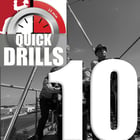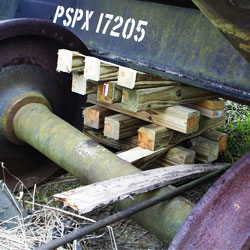 Does your company authorize employees to work at height using personal fall arrest systems (PFAS)?
Does your company authorize employees to work at height using personal fall arrest systems (PFAS)?
If so, you need to keep reading. Even if your employees don't use personal fall arrest systems, but they work at height using passive restraint, active restraint, or work-positioning systems, you need to keep on reading.
If you have demonstrated that there is no feasible means to utilize employee protection on the "Hierarchy of Fall Protection" other than fall arrest, meaning there is no way to bring the work to the ground or to use a fall restraint, then you have accepted that at some point, your employee will fall.
The personal fall arrest system (PFAS) is there to arrest their fall before they hit the ground or other hard parts, and to minimize injury during that fall and arrest event. OSHA requires employers who authorize personal fall protection systems to provide "prompt rescue," and a big reason for this is OSHA now recognizes suspension trauma as a hazard. Reference: 1910.140(c)(21) "The employer must provide for prompt rescue of each employee in the event of a fall," OSHA Safety and Health Information Bulletin (SHIB 03-24-2004, updated 2011) regarding Suspension Trauma.
Even though this is not specifically required by OSHA, wouldn't it make sense to have a prompt rescue capability for times when an employee is injured or becomes suddenly ill while working at height?
This could be an employee who is protected by passive restraint but not PFAS. For instance, if an employee needs to climb a vertical fixed ladder to access a platform with perimeter guardrails 20 feet above the next lower level and is incapacitated due to injury or illness, how will you get that employee to the ground for treatment and transport? Most likely it will require a technical rope rescue effort or some other means of getting them from height and safely to the ground.
Having Suspended Worker Rescue Preplans already in place goes a long way in preparing for the emergency of a fallen suspended worker or a worker that is injured or becomes ill but is isolated by height. By completing these preplans, it should become apparent when the requirements for viable rescue go beyond what I call the "Fred Flintstone" rescue (i.e., "so easy a caveman can do it!"). 
Additionally, there are products that will delay the onset of suspension trauma should a worker fall and remain suspended in their PFAS. These can significantly improve survivability after fall arrest while awaiting rescue.
Assisted, non-technical rescue can be accomplished using ladders, man lifts, or many other primitive but effective means. However, there comes a point where the situation will require some degree of technical rescue capability. If you have done an honest and knowledgeable assessment of the rescue needs for your facility for all the known or potential areas where you may have employees working at height, you very likely will have found the need for a technical rescue requirement.
If you are lucky, and your facility is located in a municipality that has emergency responders with a rope rescue capability that is willing and able to respond to your location, then you still must ensure that they can perform what needs to be done.
A really good way to do this is to have them come to your facility for the purposes of preplanning and hopefully demonstrating their abilities. Simply posting "911" as the plan, and calling it good, is not even close.
Some facilities have in-house teams that are equipped and trained to perform technical rescue. These in-house teams are generally the fastest to respond and it usually eliminates the problem of relying on a municipal rescue team that may be called out on a separate emergency.
For companies that do not have a municipal agency that can and will respond or does not have the technical ability to perform the types of rescues that may be required, there is always the option of training host employees to perform these types of rescue.
The first option is a single day of training using pre-engineered rescue systems or what we like to call "plug and play" systems. The second option is a two-day "build as you go" class that provides solutions in rescue environments that the pre-engineered systems are unable to cover.
Roco's one-day Pre-Engineered Rescue Systems training relies on manufactured rescue systems that require no knot tying, or the need to create mechanical advantages, or to load friction control devices. These systems are so straight forward that most students will be able to operate them safely and proficiently even if they haven't performed refresher training for several months. With these systems, you literally take the system out of a bag, hang it up to a suitable anchor, and you are ready to rescue.
Roco teaches a variety of techniques that are suitable for a conscious, uninjured suspended victim and also for an unconscious or injured victim who would need to be connected to the rescue system remotely by the use of a telescopic "gotcha pole." As straightforward and easy as this system is to become proficient with, it does have its limitations. For example, in order for this type of system to be employed, the rescuer(s) must be able to safely get into a position above or slightly offset, and within about 10 feet from the victim. If that is not possible, then it is time to prepare for a technical suspended worker rescue.
Roco's two-day Rescue From Fall Protection class teaches a limited variety of knots, including tied full-body harnesses, mechanical advantage systems, anchoring, friction control, lowering, rappelling, hauling, and line transfer systems. These skills are not that hard to master, but they are perishable and require sufficient practice at regular intervals in order to maintain proficiency. This type of "build as you go" capability allows the rescue team to create a system that will work for just about any situation and structural configuration except for the most extreme settings.
 So, if your facility seems to be behind the curve regarding the rescue of workers from height, you may need to discuss training options - either for the worker that has fallen and remains suspended from their PFAS, or for the one who is injured or ill at height with no way to get down.
So, if your facility seems to be behind the curve regarding the rescue of workers from height, you may need to discuss training options - either for the worker that has fallen and remains suspended from their PFAS, or for the one who is injured or ill at height with no way to get down.
Remember, a worker cannot hang suspended for any length of time without the danger of suspension trauma, which can be deadly.
If we can assist you in assessing your fall protection rescue needs, please contact us at info@rocorescue.com, or call our office at 800-647-7626.

 Newly revised and updated with 82-pages of color drawings and detailed illustrations, Roco's new
Newly revised and updated with 82-pages of color drawings and detailed illustrations, Roco's new  By Pat Furr, Safety Officer & VPP Coordinator for Roco Rescue, Inc.
By Pat Furr, Safety Officer & VPP Coordinator for Roco Rescue, Inc. Whenever we tie a knot in a line we lose some of the efficiency in the rope or webbing we are using. Generally, the more acute the first bend in the knot, the more efficiency is lost.
Whenever we tie a knot in a line we lose some of the efficiency in the rope or webbing we are using. Generally, the more acute the first bend in the knot, the more efficiency is lost.

 Due to their relative simplicity, belay systems rarely see the dedicated training that is often given to the other elements of rescue, such as mechanical advantage or patient packaging. Just because you can rig a 540 Belay Device or tie a Munter Hitch does not necessarily mean you are proficient in their use.
Due to their relative simplicity, belay systems rarely see the dedicated training that is often given to the other elements of rescue, such as mechanical advantage or patient packaging. Just because you can rig a 540 Belay Device or tie a Munter Hitch does not necessarily mean you are proficient in their use.

 Firstly, if there is a potential for a TSAR incident to occur within your jurisdiction, NFPA 1670 requires the authority having jurisdiction (AHJ) to address a number of “General Requirements” found in Chapter 4. The review and completion of these requirements are usually a function of the Rescue Team Leader along with key management personnel who authorize, budget, schedule, and equip the Rescue Team.
Firstly, if there is a potential for a TSAR incident to occur within your jurisdiction, NFPA 1670 requires the authority having jurisdiction (AHJ) to address a number of “General Requirements” found in Chapter 4. The review and completion of these requirements are usually a function of the Rescue Team Leader along with key management personnel who authorize, budget, schedule, and equip the Rescue Team.
 This checklist is for day-to-day incident responses under predictable jurisdictional response conditions and should not be used for disaster scenarios where large scale regional and federal resources will be required to mitigate the incident.
This checklist is for day-to-day incident responses under predictable jurisdictional response conditions and should not be used for disaster scenarios where large scale regional and federal resources will be required to mitigate the incident. 


